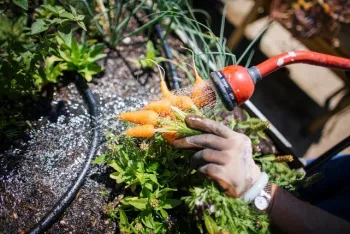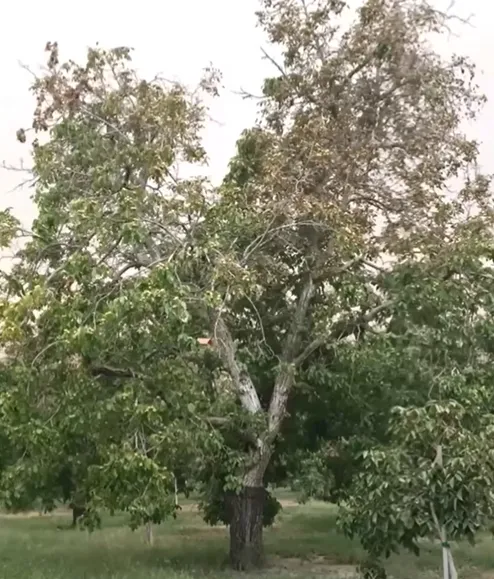Wildfires can damage your commodities and home garden produce directly or indirectly. When it comes to vineyards, smoke damage (i.e., smoke taint) is a problem that can destroy hundreds of millions of dollars in product. However, issues in home gardens and vineyards can be reduced through education and collaborative efforts to protect resources.
Home Garden and Fruit Tree Safety

Chemicals and particulate matter in wildfire smoke are associated with short- and long-term health effects. This is mainly caused by long-term exposure to particulate matter, or “PM”. When wildfires burn homes and buildings, harmful compounds and heavy metals are released during the combustion of materials such as plastics, petroleum, asbestos, and batteries. These contaminants in wildfire ash can coat garden produce and enter soils and water sources, potentially harming people through food and drinking water contamination. After wildfires, there are simple precautions you can take to reduce your exposure to potential contaminants in your garden.
During wildfires, plants accumulate chemicals and metals in numerous ways, including through deposits of ash on leaf surfaces or soil-root uptake. Plant characteristics also affect the ways these potential contaminants become stored on and within the plant. For example, root vegetables directly contact soil contaminants, while large leaves collect airborne PM (like smoke and ash) and
soil splash. Woody plants, such as fruit trees or cane berries, are less likely to pass soil contaminants touching roots into edible plant parts, but all plants can absorb airborne surface deposits through leaves. Smooth fruits, like tomatoes, squash, apples, pears, and berries, likely uptake the least compounds from airborne PM.
Humans are most exposed to wildfire contaminants directly from their environments, particularly from inhaling smoke, contacting contaminants with bare skin, and ingesting contaminants from hand to mouth. Limit your exposure and potential injury by taking precautions and protecting yourself. The best way to limit exposure to wildfire smoke and ash is by restricting outdoor activity. There are also simple actions you can take to reduce the risk of contaminants in your garden. You can practice low-impact irrigation methods, amend marginally contaminated soils with composts or other appropriate amendments, or install raised bed gardens.

Eating produce from smoky gardens carries minimal risk, however when harvesting produce from gardens potentially impacted by wildfire:
- Discard produce that is burnt or coated in soot, ash, or fire suppression chemicals.
- Discard the outer leaves of leafy greens which have the most ash and soil particles attached.
- Pre-rinse produce outside with a gentle spray or dip in potable water to remove soil, grit, ash, and other particulate matter.
- Rinse produce inside in cool, running water. Use a produce brush on hard, bumpy surfaces, and hands and fingers on smooth or delicate surfaces. Peel fruits and vegetables to remove outer layers.
Vineyard Recovery and Commodity Impacts
What is Smoke Taint?
Smoke Taint occurs when wine grapes and fruit are exposed to smoke during the growing season or during fermentation. The “taint” produces undesirable flavors ranging from “wet ashtray” to “sweaty socks” and are undetectable when tasting the fruit. These flavors ( also known as phenols) may then be released during the fermentation processes which enable even a small batch of smoke tainted fruit to contaminate an entire batch.
Smoke related issues fully develop with as little as a 30% smoke obscuration exposure for 30 minutes. While there are no known ways to remove smoke taint from the final product, there are tests available to detect the phenols associated with smoke taint. Because of the high risk of contamination from just one batch of bad grapes, if there is reason to believe smoke exposure is present, any vineyard or orchard fruit that will be fermented should be tested.
How Can I Reduce the Risk of Smoke Taint?
Ultimately the best approach to addressing smoke taint is through prevention. With wildfire size and occurrence on the rise, take measures to protect your infrastructure, crop and products.
- Learn your area’ s wildfire risks and conduct a risk assessment on your property.
- Apply “Firewise on the Farm” principals to protect property and structures.
- Create a “Fire Management Plan” for your farm that addresses your specific needs.
What Should I Do After Wildfire Exposure?
Fire-damaged crops must be tended to carefully and consistently, or you risk losing them altogether. Begin recovery of fire-damaged grapevine as soon as possible after the damage has occurred. The full extent of injuries may not fully manifest for a season, so keep tending practices regular, regardless of any positive or negative signs you might see.
- Repair your infrastructure. Look at trellis support systems; Inspect irrigation systems for fire damage; Remove any damaged tubing or irrigation systems.
- Trim scorched vines, leaves and branches. Check underneath burnt bark to see if the vine still contains viable tissue. Remember for “grafted” vines, the damaged vine must not be cut below the graft union line or else new shoots will grow from the root stock. If fire temperatures were not excessive and proper soil pH is maintained, “own-rooted” vines can be cut down to stubs and will likely re-sprout.
- Remove burnt leaves, vines and branches from the soil. Remove burnt patches of soil. Turn and fertilize the soil where grapevines were previously growing. Use a soil pH testing kit to determine the best fertilizer and soil to use. Water the areas of damaged soil regularly as if the grapevine were still growing there.
- When free of ash and debris, water the grapevine more often that you usually do. Remember, watering while ash is present can PH shock your vines or leech harmful fire byproducts into the soil. Fertilize the land around the burnt crops and continue the extra watering sessions for the entire grapevine for two to three weeks following the fire. Protect the remaining grapevines as you normally would through the end of the season
References and Resources
Videos
Vineyards and Orchards
 | Fire and Smoke Damage Mitigation in Vineyards Glenn McGourty discusses how in any location, wine grapes may be ruined when exposed to smoke from wildfires. Volatile phenolic compounds found in fresh smoke are absorbed by the leaves and fruit of wine grapes during wild fire events. These compounds bind with sugar in the fruit when the wine grapes are crushed and come into contact with skins during processing. Our study investigates how proximity to fires wind direction, temperature and fruit maturity affect the degree of damage known as "smoke taint" to fruit. |
 | Kat Jarvis-Shean, Orchard Systems Advisor in Yolo, Solano and Sacramento Counties, walks through the different ways that fire can impact orchards, the signs of damage, the timing of when to expect to see those signs, and what steps to consider based on the damage observed in the tree. Examples are from temperate orchards (e.g. olives, walnuts), so this is most relevant to Northern California growers. However, many of the considerations are relevant for sub-tropical orchards as well (e.g. citrus, avocado). Developed in collaboration with Ben Faber, UC Cooperative Extension Ventura County. |
Soils and Produce
 | Julia VanSoelen-Kim, food systems advisor for the northern San Francisco Bay Area, discusses the effects of smoke and ash on produce, some soil contaminant issues, defines how the risks are assessed, and talks about the relative risks of consuming produce grown in ash contaminated areas. |
